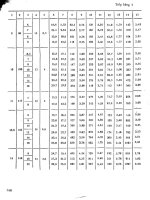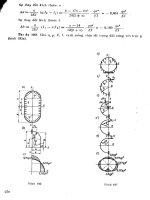Giao trinh bai tap suc ben vat lieu
Bạn đang xem bản rút gọn của tài liệu. Xem và tải ngay bản đầy đủ của tài liệu tại đây (291.37 KB, 24 trang )
STATISTICS
AN INTRODUCTION
Vuong Ba Thinh
1
Statistics
ACKNOWLEDMENT
This slides are composed using the book:
Allan G. Bluman , Elementary Statistics: A Step by Step
Approach, eighth edition 2012.
2
Statistics
OUTLINE
Statistics ? Why study statistics?
Descriptive and Inferential Statistics
Variables and Types of Data
Data Collection and Sampling Techniques
Observational and Experimental Studies
Uses and Misuses of Statistics
Software
Q&A
3
Statistics
Statistics
Examples:
Eating 10 grams of fiber a day reduces the risk of heart attack by
14%.
About 15% of men in the United States are left-handed and 9%
of women are left-handed.
Statistics is the science of conducting studies to collect,
organize, summarize, analyze, and draw conclusions from
data.
4
Statistics
Why study?
Like professional people, you must be able to read and
understand the various statistical studies performed in your
fields.
You may be called on to conduct research in your field, since
statistical procedures are basic to research.
You can also use the knowledge gained from studying
statistics to become better consumers and citizens.
5
Statistics
Descriptive & Inferential Statistics
A variable is a characteristic or attribute that can assume
different values.
Descriptive statistics consists of the collection,
organization, summarization, and presentation of data.
describe a situation
the national census
6
Statistics
Descriptive & Inferential Statistics (2)
Inferential statistics consists of generalizing from samples
to populations, performing estimations and hypothesis tests,
determining relationships among variables, and making
predictions.
make inferences from samples to populations
new drug will reduce the number of heart attacks
determine relationships among variables
Smoking and Health
7
Statistics
Descriptive & Inferential Statistics (3)
A population consists of all
subjects (human or otherwise)
that are being studied.
A sample is a group of
subjects selected from a
population.
8
Statistics
Applying the Concepts
A study conducted at Manatee Community College revealed that
students who attended class 95 to 100% of the time usually
received an A in the class. Students who attended class 80 to 90%
of the time usually received a B or C in the class. Students who
attended class less than 80% of the time usually received a D or an
F or eventually withdrew from the class.
Based on this information, attendance and grades are related. The
more you attend class, the more likely it is you will receive a
higher grade. If you improve your attendance, your grades will
probably improve. Many factors affect your grade in a course. One
factor that you have considerable control over is attendance.You
can increase your opportunities for learning by attending class
more often.
9
Statistics
Applying the Concepts (2)
1. What are the variables under study?
2. What are the data in the study?
3. Are descriptive, inferential, or both types of statistics used?
4. What is the population under study?
5. Was a sample collected? If so, from where?
6. From the information given, comment on the relationship
between the variables.
10
Statistics
Variables and Types of Data
Variables can be classified as
qualitative or quantitative.
Discrete variables assume
values that can be counted.
Continuous variables can
assume an infinite number of
values between any two
specific values.
11
Statistics
Variables and Types of Data (2)
Variables can be classified by how they are categorized, counted,
or measured - uses measurement scales, and four common
types of scales are used: nominal, ordinal, interval, and ratio.
The nominal level of measurement classifies data into
mutually exclusive (non-overlapping) categories in which no order
or ranking can be imposed on the data.
The ordinal level of measurement classifies data into
categories that can be ranked; however, precise differences
between the ranks do not exist.
12
Statistics
Variables and Types of Data (3)
The interval level of measurement ranks data, and
precise differences between units of measure do exist;
however, there is no meaningful zero.
The ratio level of measurement possesses all the
characteristics of interval measurement, and there exists a
true zero. In addition, true ratios exist when the same
variable is measured on two different members of the
population.
13
Statistics
Variables and Types of Data (4)
14
Statistics
Applying the Concepts
The chart shows the number of job-related injuries for each
of the transportation industries for 1998.
15
Statistics
Applying the Concepts (2)
1. What are the variables under study?
2. Categorize each variable as quantitative or qualitative.
3. Categorize each quantitative variable as discrete or continuous.
4. Identify the level of measurement for each variable.
5. The railroad is shown as the safest transportation industry. Does
that mean railroads have fewer accidents than the other industries?
Explain.
6. What factors other than safety influence a person’s choice of
transportation?
7. From the information given, comment on the relationship
between the variables.
16
Statistics
Data Collection
Data can be collected in a variety of ways: telephone survey, the
mailed questionnaire, and the personal interview.
Telephone surveys:
Advantages: less costly, people candid.
Disadvantages: no phone, not answer, unlisted, tone of interviewer
Mailed questionnaire surveys:
Advantages: wider geographic, less expensive, anonymous.
Disadvantage: low number of responses, inappropriate answers to
questions, have difficulty reading or understanding the questions
Personal interview surveys
Advantages: obtaining in-depth responses, .
Disadvantage: interviewers must be trained, the interviewer may be
biased in his or her selection of respondents
17
Statistics
Sampling Techniques
Four basic methods of sampling: random, systematic, stratified, and
cluster sampling.
Random Sampling: are selected by using chance methods or random
numbers.
Systematic Sampling: numbering each subject of the population and
then selecting every k-th subject.
Stratified Sampling: dividing the population into groups (called
strata) according to some characteristic that is important to the study,
then sampling from each group.
Cluster Sampling:
Here the population is divided into groups called clusters by some means
such as geographic area or schools in a large school district, etc.
Then the researcher randomly selects some of these clusters and uses all
members of the selected clusters as the subjects of the samples.
18
Statistics
Applying the Concepts
Assume you are a member of the Family Research Council
and have become increasingly concerned about the drug use
by professional sports players.You set up a plan and conduct a
survey on how people believe the American culture
(television, movies, magazines, and popular music) influences
illegal drug use.Your survey consists of 2250 adults and
adolescents from around the country. A consumer group
petitions you for more information about your survey.
19
Statistics
Applying the Concepts (2)
1. What type of survey did you use (phone, mail, or interview)?
2. What are the advantages and disadvantages of the surveying
methods you did not use?
3. What type of scores did you use? Why?
4. Did you use a random method for deciding who would be in your
sample?
5. Which of the methods (stratified, systematic, cluster, or
convenience) did you use?
6. Why was that method more appropriate for this type of data
collection?
7. If a convenience sample were obtained consisting of only
adolescents, how would the results of the study be affected?
20
Statistics
Observational & Experimental Studies
In an observational study, the researcher merely observes
what is happening or what has happened in the past and tries
to draw conclusions based on these observations.
In an experimental study, the researcher manipulates one
of the variables and tries to determine how the manipulation
influences other variables.
21
Statistics
Uses and Misuses of Statistics
“There are three types of lies—lies, damn lies, and statistics.”
“Figures don’t lie, but liars figure.”
Suspect Samples: size, how the subjects in the sample were selected.
Ambiguous Averages
Select the best
Changing the Subject
%$
Detached Statistics
Our brand of crackers has one-third fewer calories
Implied Connections
Eating fish may help to reduce your cholesterol
Misleading Graphs
Faulty Survey Questions
22
Statistics
Softwares
R
Minitab
Octave
Matlab
Microsoft Excel
SPSS
Stata
23
Statistics
Q&A
24
Statistics









